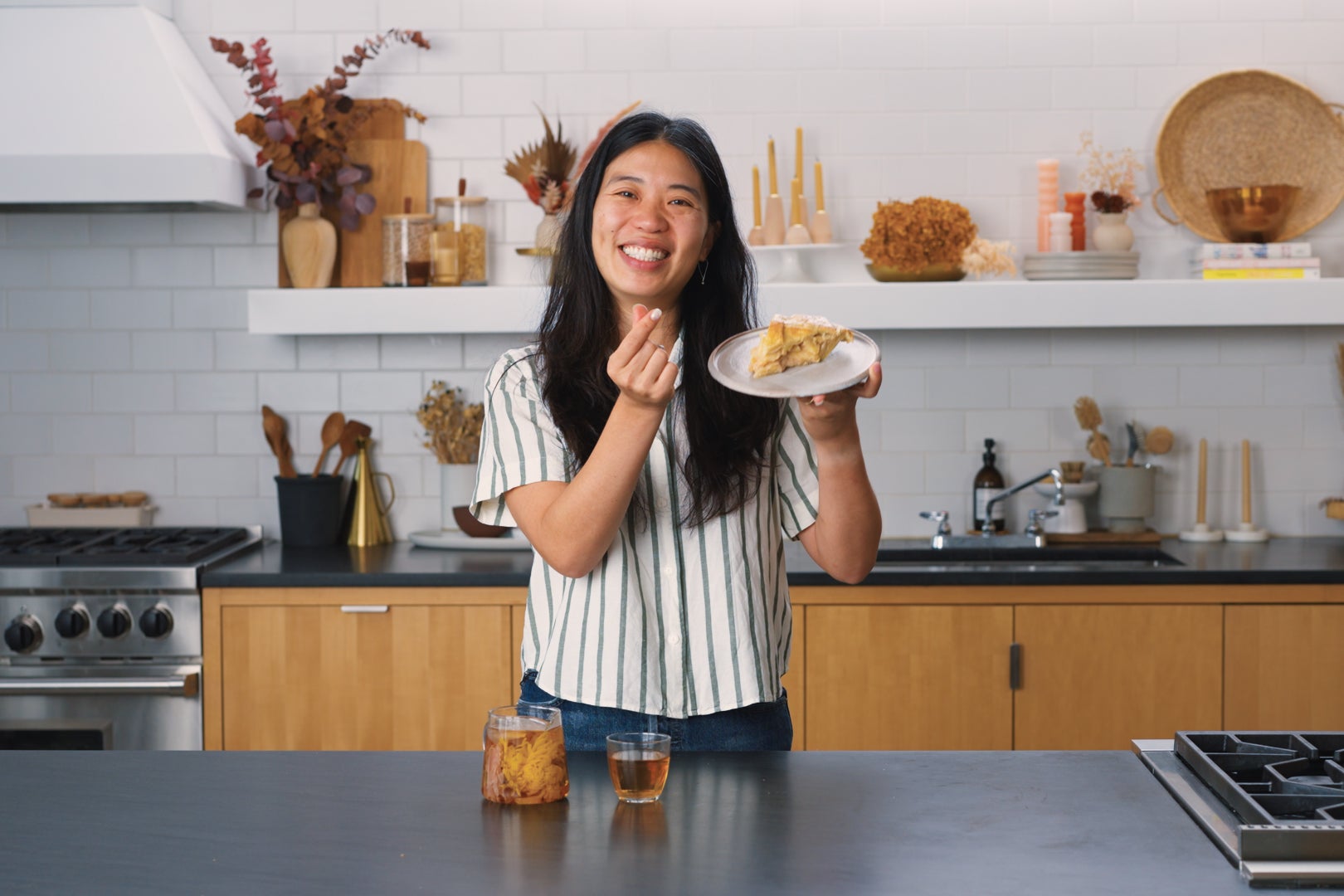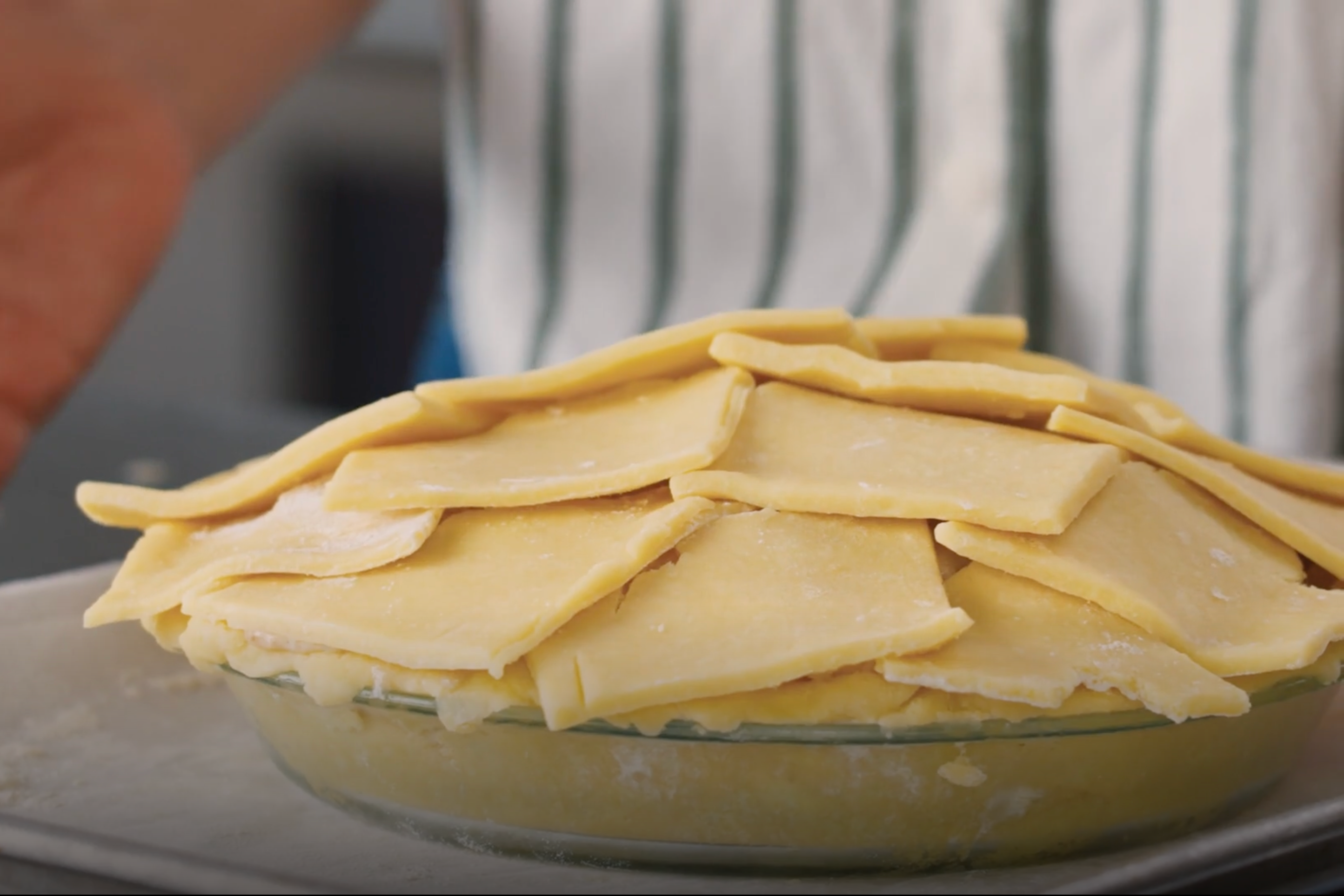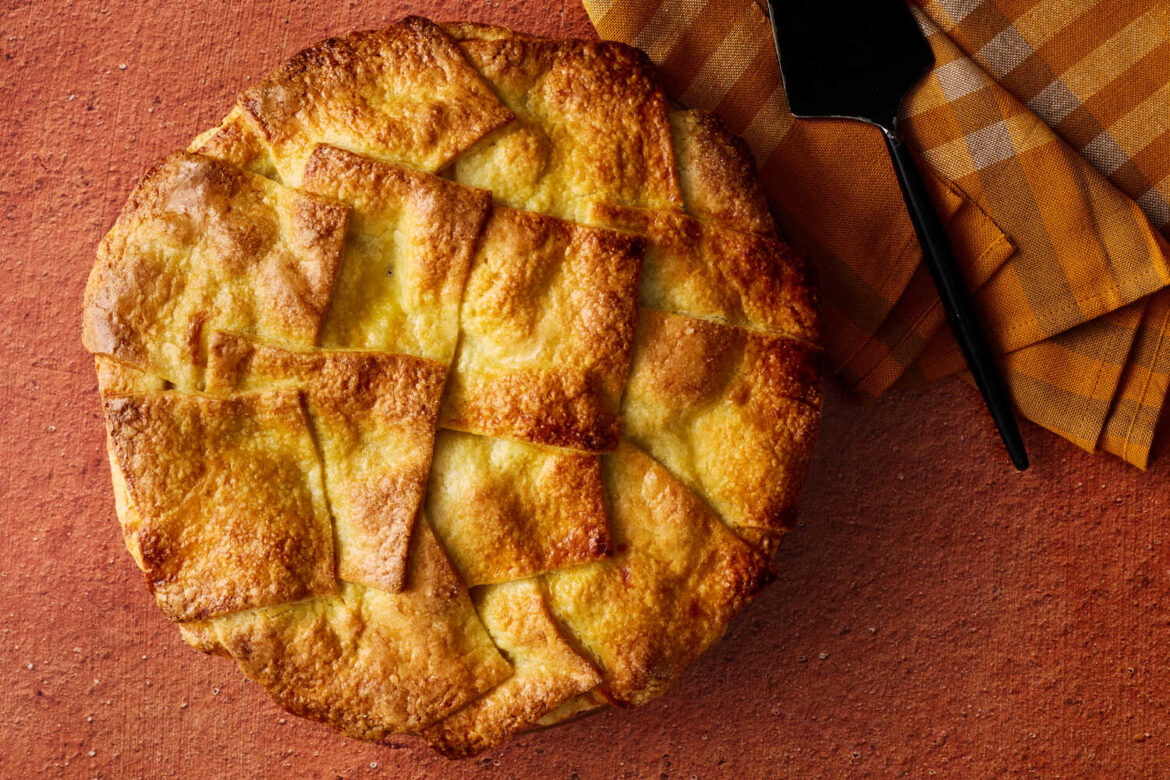Sign up for the Slatest to get the most insightful analysis, criticism, and advice out there, delivered to your inbox daily.
In theory, Thanksgiving is a holiday built around family togetherness. But that wholesome branding belies yet another point of bitter division in American life: the split between those who want only the classics on their plates, unedited and unadorned, and those—often the cooks—who wouldn’t mind changing things up. It’s on behalf of the latter group that recipe developers toil each year, doing their best to reinvent, or at least refresh, old standards like sweet potato casserole, cornbread stuffing, and, of course, the bird. Thankfully for these underappreciated artisans, the dessert buffet can offer a little more leeway for creativity and innovation … just as long as you don’t mess with the pies.
Which is why, when I learned that New York Times Cooking recipe creator and food stylist Sue Li was about to come out, whisks blazing, with a radical take on the vaunted apple pie, I had to 1) make sure she was OK and 2) find out more. Li’s Apple and Cream Pie—which is part of a collection of six new pie recipes that she dropped this week—takes a few liberties with the iconic dessert, but the biggest provocation is her approach to its most troublesome element: the wretched lattice. On the eve of her brave foray into the Thanksgiving foodie fray, I spoke with Li about her elegant no-weave solution, her feelings about the holiday’s traditional palate of flavors, and what pies of the future should be wearing on their big day. This conversation has been edited and condensed for clarity.
Bryan Lowder: The thing that I imagine is tough about Thanksgiving recipe development is that every year, you’re having to revisit these dishes or flavors and say something new about them in one way or another. What theme did you have in mind for your collection of pies this go around?
Sue Li: I’ve worked in food media for a long time behind the scenes, and you’re right: When it comes to creating Thanksgiving flavors, there’s a lot of cinnamon, a lot of nutmeg, pumpkin, cranberries, all those things. I personally have just gotten tired of those flavors because I have to think about them constantly. It’s something that I have to cook in the summertime [when holiday recipes are tested] and it’s hot, and I think I just wanted something that is more me. Thanksgiving isn’t something that I grew up celebrating, but it’s something that I learned about through my work, and so I had to infuse the way that I approach eating and the flavors that I like, which are a little bit lighter, a little brighter, and a little less sweet.

Recipe developer and food stylist Sue Li
Matthew Young/New York Times
Apple is one of the most revered pies of the Thanksgiving canon and seems kind of tricky to mess with. What drove you to want to take that one on in particular?
It was scary! There are a few things that I felt were intimidating about pies with pie dough, and I wanted to dispel them. That is why I was like, Let me tackle the apple pie, which is the most American thing. Obviously, if you looked at me, you wouldn’t think that I’m somebody who would make a very American apple pie, but I’ve eaten a lot of different types of pies. All the recipes that I think people have made in their homes, from magazines, whatever articles they’ve read, I have had to make them through my line of work. I’ve just touched so many pies, and I realized along the way that there are easier ways to tackle the dough. There don’t need to be so many rules. Do you feel like you’ve had that experience? It’s always like: Don’t use too much water. Move fast. That butter has to be super cold.
There can be a lot of stress about it, for sure.
I just wanted to make a double-crust apple pie that has no crimping, and the dough should be really easy. I think I was bold in trying to tackle it. I’m really proud of it.
Right, let’s get into the specific elements of this recipe. It’s called “Apple and Cream Pie,” not just apple pie. So that’s signaling to us that the heavy cream is important. The pie filling definitely has sort of a softer, more blended vibe overall. We’re sauteing the apples in butter first, instead of just tossing them with the sugar and spice, which most recipes would have you do. We’re using a sweeter apple, the Honeycrisp, and then you’ve got ½ cup of cream. What were you wanting to achieve there?
I don’t like my desserts to be too sweet, so I feel like when you’re using a Granny Smith, which is a very traditional apple-pie apple, it’s so tart that you need to add extra sugar. When you’re adding sugar, you’re also adding moisture. Sometimes it takes a little longer to cook. Parcooking the apples takes some of the moisture away, and there can be a little less sugar because the apples are already pretty sweet. And with the cream, you don’t necessarily taste it when you’re eating. It’s just sort of silkier than normal, and it has just a little bit of cinnamon. It’s more about the apples, and the cinnamon just takes you down that classic route for a little bit.
OK, so the crust: This is the big news. The dough is a pretty standard all-butter pie dough. But we’re here to talk about the lattice. I bake a lot, but with lattices, I’ve attempted it once or twice, and it’s so frustrating and fiddly that I’ve never really done it again. So what you’ve done here is create a version of that that’s shingled rather than woven, but it still gives you that three-dimensional, dramatic feel that a lattice does, without all of the trouble. How did you get that idea? Did you have any visual inspiration or reference points?

Matthew Young/New York Times
I have a really good friend who is a pie baker based in Los Angeles. Her name is Nicole Rucker. She owns this pie shop called Fat and Flour. And at one point, she was telling me about how she was making her double-crust pies, where all she did was lay—which is apparently a classic French technique—a piece of crust on top and that was it. Maybe they make a hole in the center, but they didn’t even crimp the sides. She showed me pictures, and they were so beautiful and cool.
So what I wanted here was to make it so we had a more visually stunning pie. And I wanted to make it simple because I myself find it so stressful. If I’m preparing a dinner party or whatever, the kitchen is hot. If I’m latticing dough, things are just falling apart and I’m having a meltdown. If you do it like this, you just layer [the squares of dough] on, really. People can cut it into any shape they want. You can cut it into strips too, if you want. I don’t care. Just lay it on.
When you say “any shape they want,” could we get out our cookie cutters here and do fall leaves or something?
You can! Or you can get out a ring cutter and just cut circles, or you can cut triangles. You can cut different types of trapezoids—
Irregular polygons!
Sure, polygons, and just put it on top and throw in the oven and know that whatever comes out will be really fun to look at. And also, you get so much crust.

Matthew Young/New York Times
What do you mean by that?
When there’s latticing, there’s going to be bites when you don’t get crust. But with this, you’re getting a crust on the top and the bottom, and from the overlaps there’s going to be extra crust. For me, when it comes to a pie, I love a nice flaky crust. And something else that I ask people to do in the recipe is to preheat a baking sheet in the oven so the bottom is getting cooked too. I think that’s something that people don’t realize: If you’re preheating your oven, you throw a baking sheet in there, and it actually helps you cook the bottom crust.
All right, so you’ve solved the lattice. But because we’re not crimping, I can imagine some people being concerned about what the edge is going to look like on this.
If you’re not crimping, you’re not really sealing the edges. So the steam will be able to come out. And that helps it too, because most of the time when you’re doing a double-crusted pie, you do need to have vent.
And then the shingles kind of drape down, right? So they’re going to create a good edge.
They kind of make a nice skirt.

Matthew Young/New York Times
That sounds great. Do you think that this shingling technique would work elsewhere? I’m actually making this Butter Chicken Pot Pie tonight that’s been going around Instagram, and I was thinking of doing this on it.
Oh my God, you should! Any pie, savory, sweet. Any type of pie. Just shingle it on.
The Most Annoying Part of Baking Has Ruined Too Many Thanksgivings. There’s Finally a Better Way.
Restaurants in Boston and Philly Have Finally Gotten Some Michelin Stars. The Reason Why Should Give You a Stomach Ache.
Now Tech Bros Want to Disrupt Your Trip to the Grocery Store. Their Plans Aren’t Pretty.
This Content is Available for Slate Plus members only
Recipes Always List Onions by Size, but Who Decides What “Medium” Means? I’ve Found a Better Way.
Just shingle it on! OK, turning back to the full pie collection, is there one that you really hope people would try, aside from the Apple Cream?
Oh, yeah. I do have a favorite: The Chocolate-Espresso Pie. It’s so good. The crust is made with chocolate Teddy Grahams.
Ohhhhh …
And you make a rich chocolatey pudding. And then you make an espresso pudding. And the espresso pudding has white chocolate in it to give it extra chocolate. And then you top it with unsweetened whipped cream because it helps to balance out all the sweetness from the puddings. And the way I make it, it’s layered. So when you slice into it, it’s really stunning. It’s delicious. It tastes like an ice cream cone. I keep saying that because it really tastes like an ice cream cone.
So do that with the apple pie. And if you want something lighter, then maybe do the Cranberry Mousse Pie, which looks like a marbled pink cloud. Actually, it also sort of looks like a dress.
See these pies and all of Sue Li’s recipes for New York Times Cooking here.

Sign up for Slate’s evening newsletter.


Dining and Cooking